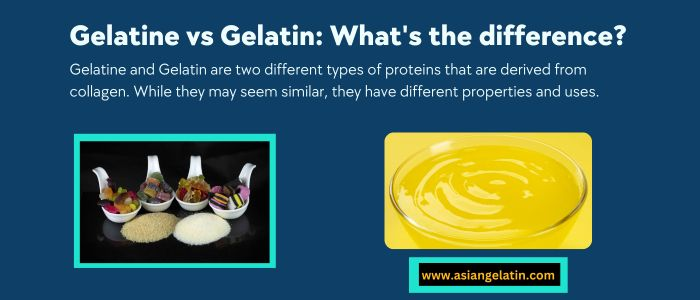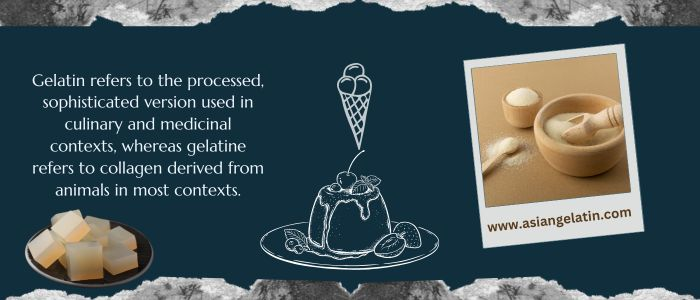Are you not known to be a gelato gourmet who discovers slight differences between brands from time to time? Do you find the words "gelatine" and "gelatin " confusing? Getting the appropriate responses to those questions takes time since no longer educated cooks understand the difference.

Before diving into the debate, familiarize yourself with the definitions and variations of those not-uncommon factors. Our blog article on gelatin and gelatine will explain their distinctive capabilities and ensure your subsequent culinary journey is as tasty as possible.
What Sets Gelatin Apart from Gelatine?
Despite their common interchangeability, gelatine and gelatin do not have the same meaning. Despite their similarities, they also differ in important ways. Here, I will explain how gelatin and gelatine float and examine and compare their compositions, uses, and applications.
Composition:
Gelatin :
Bones, tendons, and skin are just a few examples of animal tissues that contain collagen, the protein that contains gelatin. The denaturation process breaks down collagen fibers and then reassembles them to create a gel-like substance. Thickening, stabilizing, and gelling are the three main functions of gelatin inside the food area.
Gelatine:
Bones from farms and domestic animals, such as pigs, are the best sources of gelatine. Candy and marshmallows are some of the confections that rent it. Gelatine is a versatile element that works in many different dishes due to its excellent properties, such as its ability to both set and soften at high temperatures.
Functions and Purposes:
Gelatin: A Versatile Ingredient in Various Products
Gelatin is a gelling agent widely used in many products due to its adaptability. With its gel-like consistency and set-ability, gelatin has become a popular gelling component in candies like gelatin treats and Jello. Its ability to thicken soups, sauces, and dressings makes it essential for achieving a velvety, creamy consistency.
Additionally, gelatin finds application in cosmetics, medicines, and food products as a stabilizer, helping to maintain the strength of these items and enhance their longevity.
Gelatine: a gelling ingredient
Gelatin is used as a gelling agent in the food sector as confectionery items such as sweets and marshmallows. Good examples of its use include gummy bears and worms, as it is obtained from the denaturing of collagen. Marshmallows, made using gelatine, have a distinctive spongy feel due to the material's elasticity and plasticity, which also helps in medical dressing.

Comparison of Gelatine and Gelatin in Various Industries:
While gelatine and gelatin mean different things in the food industry, they are generally used interchangeably.
- Generally, gelatin refers to the processed, sophisticated version used in culinary and medicinal contexts, whereas gelatine refers to collagen derived from animals in most contexts.
- It is also possible for a sweet manufacturing company to rent gelatine from animals to make gummy candies.
- A pharmaceutical enterprise would use subtle gelatin when making remedy capsules because of its higher purity and excellent control.
- Identifying the specific characteristics and using these objects in diverse sectors requires differentiation.
- Collagen, found in animals' skin, connective tissues, and bones, is a water-soluble protein determined in gelatin. The British English spelling is gelatine.
- French "gélatine" or German "Gelatine" have also incorporated their forms into English.
Conclusion:
Despite being used interchangeably, gelatin and gelatine have important differences. Gelatin is a protein derived from collagen, and gelatin is derived from bones. It is extensively used as a gelling agent in meal products due to its special qualities. When searching for or making gelatin recipes, a recipe for panna cotta may be made with gelatine instead of the particular gelatin, so it is useful to recognize the difference between gelatin and gelatine.
Post time: Dec-16-2023






